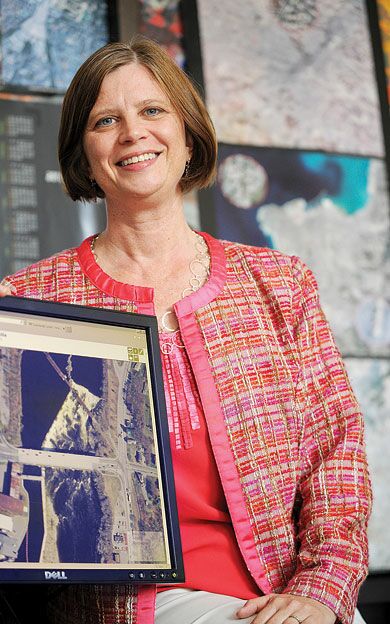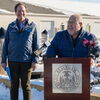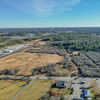Processing Your Payment
Please do not leave this page until complete. This can take a few moments.
- News
-
Editions
View Digital Editions
Biweekly Issues
- December 1, 2025
- Nov. 17, 2025
- November 03, 2025
- October 20, 2025
- October 6, 2025
- September 22, 2025
- + More
Special Editions
- Lists
- Viewpoints
-
Our Events
Event Info
Award Honorees
- Calendar
- Biz Marketplace
Woman to watch: Claire Kiedrowski, Kappa Mapping Inc.
 PHOTo / Amber Waterman
Claire Kiedrowski, owner and president of Kappa Mapping Inc. in Bangor, has built a strong portfolio using technology in innovative ways with clients in Maine, the United States, Canada and Europe.
PHOTo / Amber Waterman
Claire Kiedrowski, owner and president of Kappa Mapping Inc. in Bangor, has built a strong portfolio using technology in innovative ways with clients in Maine, the United States, Canada and Europe.
 PHOTo / Amber Waterman
Claire Kiedrowski, checks on a mapping project with co-worker Mary Beth Parent at Kappa Mapping Inc. in Bangor.
PHOTo / Amber Waterman
Claire Kiedrowski, checks on a mapping project with co-worker Mary Beth Parent at Kappa Mapping Inc. in Bangor.

Claire Kiedrowski, owner and president of Kappa Mapping Inc. in Bangor, has no trouble explaining how her team will carefully eliminate distortions caused by an airplane's yaw, pitch and roll in order to ensure the accuracy of maps created by stitching together dozens of digital aerial images. And if you want to know where wetlands and vernal pools might be located in relation to a potential commercial development, she'll explain in detail the advantages of color infrared aerial imagery.
As well-versed as she is in discussing the intricacies, options and advantages of aerial mapping, Kiedrowski has her feet planted firmly on the ground. She began her map-making career as a surveyor soon after graduating from the University of Maine in 1990. What she liked about that work is the way it combined historical, visual and mathematical information — researching paper records at registry of deeds offices to supplement surveys in the field using a theodolite (the device that measures angles on terrain) and chains. It gave her a solid understanding of how the lay of the land and history can influence decisions about a particular place's best use.
“My role is to know what the client really needs,” she says. “I'm adept at asking the right questions in order to arrive at the right specifications for the job in hand.”
Kiedrowski says her company's involvement in a five-year aerial mapping project of the entire state — as a subcontractor for Woolpert, a national mapping company based in Ohio — is a prime example of how aerial mapping has become a sister technology to the older discipline of surveying.
Using the modern mapmaking tool of orthoimagery, which provides a detailed aerial view of the landscape with true distances between different features and points, the Maine GeoLibrary Project seeks to create an electronic gateway to public geographic information and to expand and promote the value of geographic spatial data through widespread distribution and innovative use for Maine's citizens.
Starting in Cumberland and York counties in 2012, the project will proceed in counter-clockwise fashion to collect aerial maps of each Maine county over five years. The first round of aerial mapping was funded by grants from the Maine Department of Transportation, Maine Emergency Management Agency, Maine GeoLibrary, U.S. Geological Survey and Cumberland County. This summer, the mapping continues in Androscoggin, Kennebec, Sagadahoc, Lincoln, Knox counties and the city of Belfast.
“Tons of people can use this information,” Kiedrowski says, naming as potential users planning and economic development officials, private developers, emergency responders, public works departments, environmental organizations, municipal assessors and citizens as among potential users.
The program will provide base imagery at a reduced cost, as well as several buy-up options, that can be used for a number of projects or activities. In the first year covering York and Cumberland counties, 22 communities opted to buy the highest-resolution imagery and seven towns purchased the next level of sharpness. In both situations, Kiedrowski says, the communities are getting a great deal in obtaining detailed and accurate aerial maps at far less cost than if they went it alone.
“They don't have to pay to get the plane in the air,” she says.
Kiedrowski's personal journey as a mapmaker runs roughly parallel to the rapid changes taking place in the mapping industry. Building on her surveying skills, over two decades she has learned photogrammetry, orthophotography, geographic information systems and LIDAR (light, detection and ranging), which uses sophisticated aerial laser technology to create a very precise model of the elevation and topography of an area.
“It's been quite a ride — a very, very exciting ride,” she says.
Leading an 'ensemble'
When the opportunity presented itself in 2003 to buy a well-established mapping company in downtown Bangor, she jumped at it.
“I was in my early 40s and I wanted to be part of something I could develop and grow,” she says. “I love being in an ensemble with my employees … The most interesting stories, I think, are ones that don't just have a central character and that's it. We're all pretty fluid in terms of the hierarchy here. Sometimes an employee takes the lead role and has a 'solo,' sometimes they step back and let someone else have the solo.”
Since then, she's met head-on the problems that come with owning a business in a field that's very competitive and dependent on rapidly evolving technology. Digital imagery and sophisticated visual software make it possible to quickly do jobs that once took six months to a year to complete — but the accelerated turnaround times can be quite challenging.
And Kiedrowski knows full well there are big mapping shops in India and China with upwards of 1,200 workers who are getting paid $15 a day to do the kind of work Kappa Mapping does.
“How do you compete with that?” she asks. “Excellence. That's the key. It's why we're still relevant.”
As a small company, Kappa can't simply buy the best and latest computer software or hardware as soon as it's available, so Kiedrowski says she made a point of hiring workers who are creative problem-solvers. Her team of eight employees, she says, shares her commitment to staying on top of mapping industry trends by regularly taking webinars and reading trade journals.
Quite often, she says, they find innovative ways of using traditional technologies to solve mapping problems.
It's a trait that has earned Kappa accolades for four consecutive years in the annual Geospatial Products and Services Excellence Awards competition sponsored by the Management Association for Private Photogrammetric Surveyors, the national association of private geospatial firms. In 2012, for example, Kappa earned the Small Projects award for its work mapping more than 65,000 lobster fishing buoys and lines along Maine's coast in relation to the migration routes of endangered right whales. It used stereo imagery technology to pinpoint and map those lobster buoys, analyzing 6,000 aerial images in the process.
Since 2003, Kappa Mapping has worked on hundreds of projects throughout the United States, Canada and Europe. Sometimes, as in the Maine GeoLibrary Project, it's as a sub-contractor partner with a much-larger mapping, engineering or surveying company. But whenever she can, Kiedrowski enjoys the challenge of managing a project from start to finish. Those jobs expand the company's portfolio and enhance its reputation in Maine and beyond.
Kiedrowski takes pride in the repeat customers who hire Kappa to do their mapping projects.
Among them is the Maine Department of Transportation, which hired her company to produce engineering-grade mapping for the $84 million Penobscot Narrows Bridge to replace a decaying 1931 bridge across the lower Penobscot River. The replacement bridge, which opened in December 2006, was completed in just 42 months — putting tremendous pressure on the mapping, surveying and design phases Kappa was involved in.
In the fall of 2011, MDOT tapped Kappa to do an updated base map to guide S&R Corp., the Lowell, Mass.-based engineering and construction firm hired last year to plan and dismantle Waldo-Hancock Bridge with minimal impact on traffic and wildlife.
Kappa also is partnering with the engineering firm Hoyle, Tanner & Associates to create “airport obstruction maps” — compliant with Federal Aviation Administration requirements and other guidelines for instrument flight air traffic — for small regional airports in northern Maine. A similar effort with Hoyle, Tanner for the Danbury, Conn., airport in 2009–2010 earned Kappa other accolades from MAPPS in 2011.
In the judges' comments, the firm's ingenuity and flexibility were singled out by Robert Burtch, chairman of the panel, who wrote, “Larger firms may have more assets, but Kappa expertly modified their hardware and software to meet client needs. They were willing and able to adapt when the scope of the project changed.”
Looking ahead, Kiedrowski says she hopes to roughly double the company's yearly revenues within five years to $1.5 million and expand from 12 to 15 employees.
“I want to still have a small business feel to our company, but be a tad more profitable,” she says. “I'd like to put Maine on the map in terms of geospatial excellence. I know from experience we're a good value for our clients.”
Read more
Kappa Mapping Inc.
Address: 6 State St., Bangor
Founded: 2003
Employees: 8
Services: Aerial photography, photogrammetry and digital mapping services
Revenue, three-year average: $604,135
Contact: 866-836-8834
In her own words
What was the biggest challenge of your career? Obtaining the confidence to leave a well-paying job to start my own business
When did you know you'd made it? Making it is a journey, not a destination. But two things come to mind: when I was recognized for our work by a national professional organization, and when a college student toured our office during a field trip said, 'This is what I want to do when I graduate.'
What advice do you wish you'd been given early in your career? Develop mentors early. Mentors come in all shapes and sizes, some last throughout your career, and some are involved only very briefly. Also, participate in your profession's national organizations — I saw an increase in business when I joined MAPPS — a geospatial organization focused on the business owner.
I'll relax when …? I'm in the process of defining what this looks like….
What was your 'Haven't we moved beyond this?' moment? Why do we still have cash flow issues?
Mainebiz web partners

The Giving Guide
The Giving Guide helps nonprofits have the opportunity to showcase and differentiate their organizations so that businesses better understand how they can contribute to a nonprofit’s mission and work.
Learn More
Work for ME
Work for ME is a workforce development tool to help Maine’s employers target Maine’s emerging workforce. Work for ME highlights each industry, its impact on Maine’s economy, the jobs available to entry-level workers, the training and education needed to get a career started.
Learn More
Groundbreaking Maine
Whether you’re a developer, financer, architect, or industry enthusiast, Groundbreaking Maine is crafted to be your go-to source for valuable insights in Maine’s real estate and construction community.
Learn more-
The Giving Guide
The Giving Guide helps nonprofits have the opportunity to showcase and differentiate their organizations so that businesses better understand how they can contribute to a nonprofit’s mission and work.
-
Work for ME
Work for ME is a workforce development tool to help Maine’s employers target Maine’s emerging workforce. Work for ME highlights each industry, its impact on Maine’s economy, the jobs available to entry-level workers, the training and education needed to get a career started.
-
Groundbreaking Maine
Whether you’re a developer, financer, architect, or industry enthusiast, Groundbreaking Maine is crafted to be your go-to source for valuable insights in Maine’s real estate and construction community.
ABOUT
NEW ENGLAND BUSINESS MEDIA SITES
No articles left
Get access now
In order to use this feature, we need some information from you. You can also login or register for a free account.
By clicking submit you are agreeing to our cookie usage and Privacy Policy
Already have an account? Login
Already have an account? Login
Want to create an account? Register
Get access now
In order to use this feature, we need some information from you. You can also login or register for a free account.
By clicking submit you are agreeing to our cookie usage and Privacy Policy
Already have an account? Login
Already have an account? Login
Want to create an account? Register






Comments